Jalapeño cheddar sourdough is an easy way to amp up the flavour of a basic sourdough loaf! Eat it plain, or slathered with butter and jam. Yes, jam! The sweetness of jam is a terrific compliment to the spicy jalapeños and rich salty cheese.
Spice up your standard sourdough even more with black pepper rosemary sourdough bread, cinnamon raisin sourdough, and walnut cranberry sourdough bread.

Jump to:
Ingredients

Ingredient Notes and Substitutions
- Flour: use bread flour in place of all-purpose if you like.
- Cheddar: for the best flavour, choose an aged sharp cheddar. You can try other cheeses like Monterey Jack, Havarti, or Swiss.
- Jalapeño pepper: jalapeño and cheddar make a classic combo, but you can substitute any other fresh chilli pepper you want. You can also replace the fresh jalapeño with about a teaspoon (or more if you’re brave) of chilli flakes.
- Starter: this should be 100% hydration sourdough starter at its peak, made with any flour that contains gluten (white, whole wheat, etc.).
Method
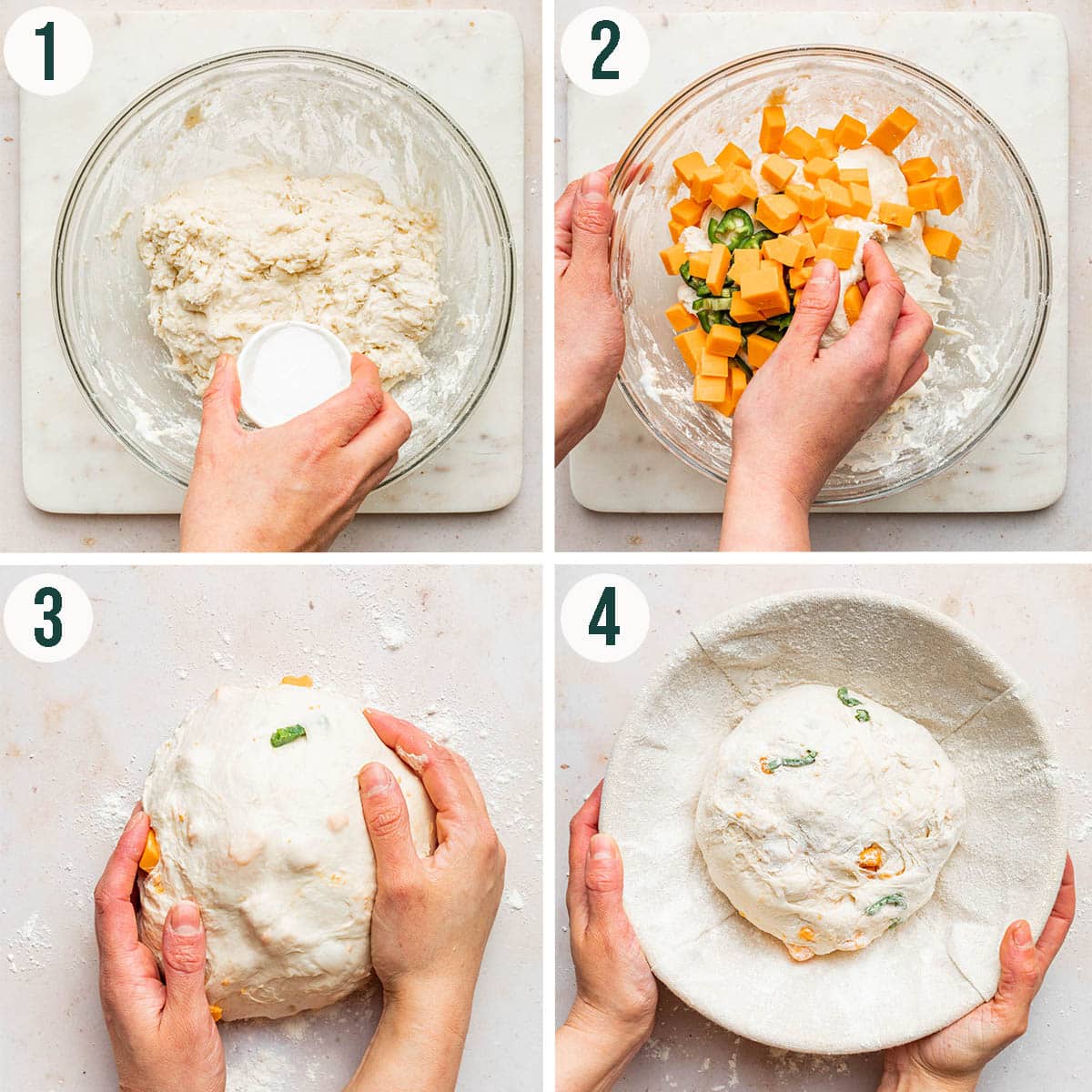
Step 1: mix the starter, water, and flour, then mix in the salt.
Step 2: add the cheddar and jalapeño and mix to combine.
Step 3: do the stretches and folds, then shape the dough into a boule.
Step 4: place the dough into a banneton to ferment overnight.
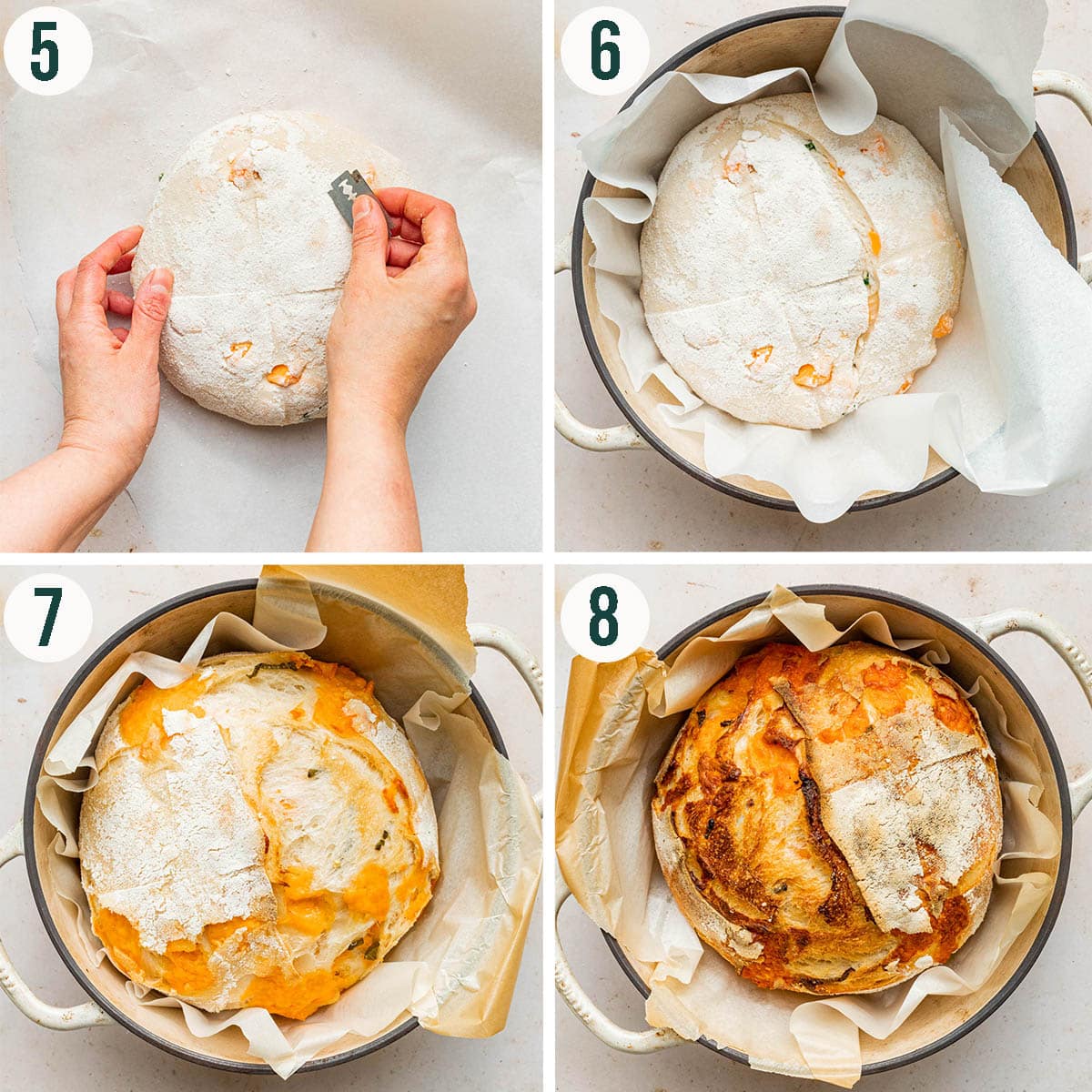
Step 5: turn the dough out onto parchment paper and score.
Step 6: place into a preheated dutch oven.
Step 7: bake for 30 minutes, covered.
Step 8: bake for another 20 minutes uncovered and cool before slicing.
Tips & Notes
- Watch the bottom crust: because of the added fat in the cheese, the bottom of this loaf may brown faster than regular sourdough—if you don't like a thicker crust, try doubling up the parchment paper.
- Dial up the heat: we only use one pepper in this recipe, but if you like lots of heat, you can add more. We don't recommend using canned or pickled jalapeños.
- Serving suggestions: we love this bread for tuna or tomato sandwiches, toasted for breakfast, or as a side for soup. It makes the best double-cheese grilled cheese, too.
Recipe Notes
Please note that we do not include cup measurements for this cheddar sourdough bread (or any of our sourdough bread recipes for that matter). Making homemade sourdough requires precision. We highly recommend using a scale to measure ingredients by weight for best results.
How to Store
Storage: keep the bread in a paper bag, with the cut end wrapped in beeswax wrap, or in a cloth bag or bread bin for 3-4 days. This loaf doesn't last as long due to the additions.
Freezing: either freeze the whole loaf, wrapped very well, or individual slices in an airtight container. Thaw slices in the toaster for a quick meal.
Sourdough Essentials
If you're new to sourdough baking, check out these guides before you begin:
How To Make Sourdough Starter From Scratch
Essential Sourdough Tools
How To Stretch And Fold Sourdough
How To Shape Sourdough Boules
Troubleshooting Sourdough Bread

FAQ
What to eat with cheddar jalapeno bread?
Try it with a sweet jam for an interesting contrast, breakfast eggs, tomato soup, as a tomato or vegetable sandwich, with chicken salad – the options are endless and it pairs well with just about anything.
Why is sourdough bread so much better?
Sourdough uses wild yeast rather than commercial, and relies on a much longer fermentation or proving period that makes the gluten easier for some people to digest. This long fermentation period improves the flavour, too, making for a tastier loaf.
Does cheddar cheese melt when baked?
Cheddar melts well when baked, making for pockets of melted cheese in the bread that are particularly tasty.
More Sourdough Bread Recipes
If you make this Jalapeño Cheddar Sourdough Bread recipe or any other sourdough bread recipes on the Baked Collective, please take a moment to rate the recipe and leave a comment below. It’s such a help to others who want to try the recipe. For more baking, follow along on Instagram, TikTok, and YouTube.
Jalapeño Cheddar Sourdough Bread
Equipment
- Mixing bowl
- Banneton
- Dutch oven
- Parchment paper
- Bread lame or razor blade
- Wire rack
- Digital kitchen scale
Ingredients
- 440 grams all-purpose flour
- 320 grams water room temperature
- 100 grams active sourdough starter
- 10 grams salt
- 150 grams old cheddar cubed into ½-inch (1 cm) chunks
- 1 jalapeño sliced lengthwise, chopped into half moons
Instructions
Make The Dough (about 50 minutes)
- Add the flour, water, and starter to a large bowl. Using your hands, mix until a shaggy dough forms.
- Once the dough is mixed, cover the bowl with a tea towel. Let the dough rest at room temperature for 40 minutes.
- After the 40 minute resting time has elapsed, add the salt, cubed cheddar, and sliced jalapeño. Mix with your hands until well combined.
Stretch & Folds (about 3 hours)
- To do this, dampen your hands lightly with water. Reach under the dough on the opposite side of the bowl from you. Pull the dough up and over towards you. Turn the bowl a quarter turn and repeat on all four quadrants of the dough. Scoop your hands under the ball of dough and flip it over completely. This completes one stretch and fold. Do 6 more series of stretch & folds, one every 30 minutes, for a total of 3 hours.
Shape The Dough (30 minutes plus 8 hour rest in the fridge)
- Lightly dust a work surface with flour. Remove the dough from the bowl and let it rest on the counter for 20 minutes.
- Generously dust the inside of a banneton with flour (we like a mix of 1:1 all-purpose flour and rice flour).
- Shape the dough into a boule. You want as much surface tension as possible without tearing the outside of the loaf. Once shaped, turn the loaf into the prepared banneton (top-down, seam side up). Lightly flour the exposed dough. Cover the banneton with a plate and set it in the fridge overnight, or for at least 8 hours.
Day Two (about 1½ hours plus 5 to 6 hours of cooling time)
- The next day, place a cast iron Dutch oven in the oven with the lid on. Preheat the oven to 500°F (260ºF) (or as hot as your oven can go, but no higher than 500°F). After the oven has come to temperature, continue to preheat the Dutch oven for another 30 minutes.
- Once the Dutch oven has preheated, have a large square of parchment paper ready on a work surface. Take your bread out of the fridge. Gently invert the dough onto the parchment paper. Gently score the bread with a bread lame or a razor blade.
- Using oven mitts, carefully remove the Dutch oven from the oven, take off the lid, and then carefully lift the dough into the pot using the parchment paper as handles. Using oven mitts, carefully place the lid back on the Dutch oven and back into the heated oven.
- Reduce the heat to 450°F (230ºC) and bake the loaf for 30 minutes.
- Take the pot out of the oven, carefully remove the lid (be careful of steam), and bake for another 20 minutes with the lid off.
- Remove the pot from the oven. Remove the lid and carefully lift the loaf out using the edges of the parchment paper as handles.
- Place the loaf on a wire rack and pull the paper away from underneath the loaf (if heat makes it too difficult to extract the dough and parchment layer safely, just let the loaf cool in the Dutch oven—don't risk burning yourself). Cool the bread completely before slicing, about 5 to 6 hours.

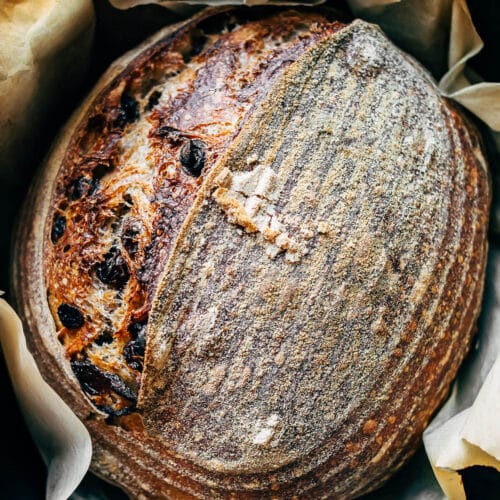
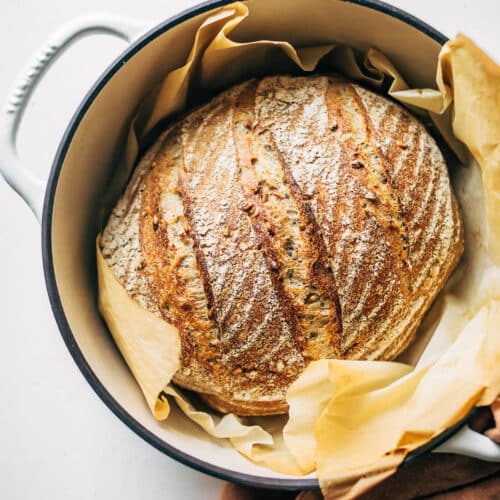
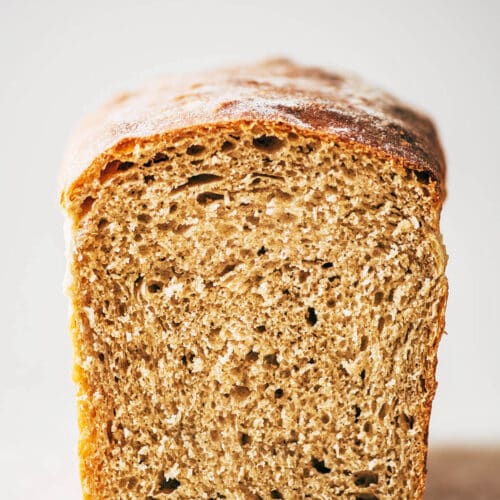

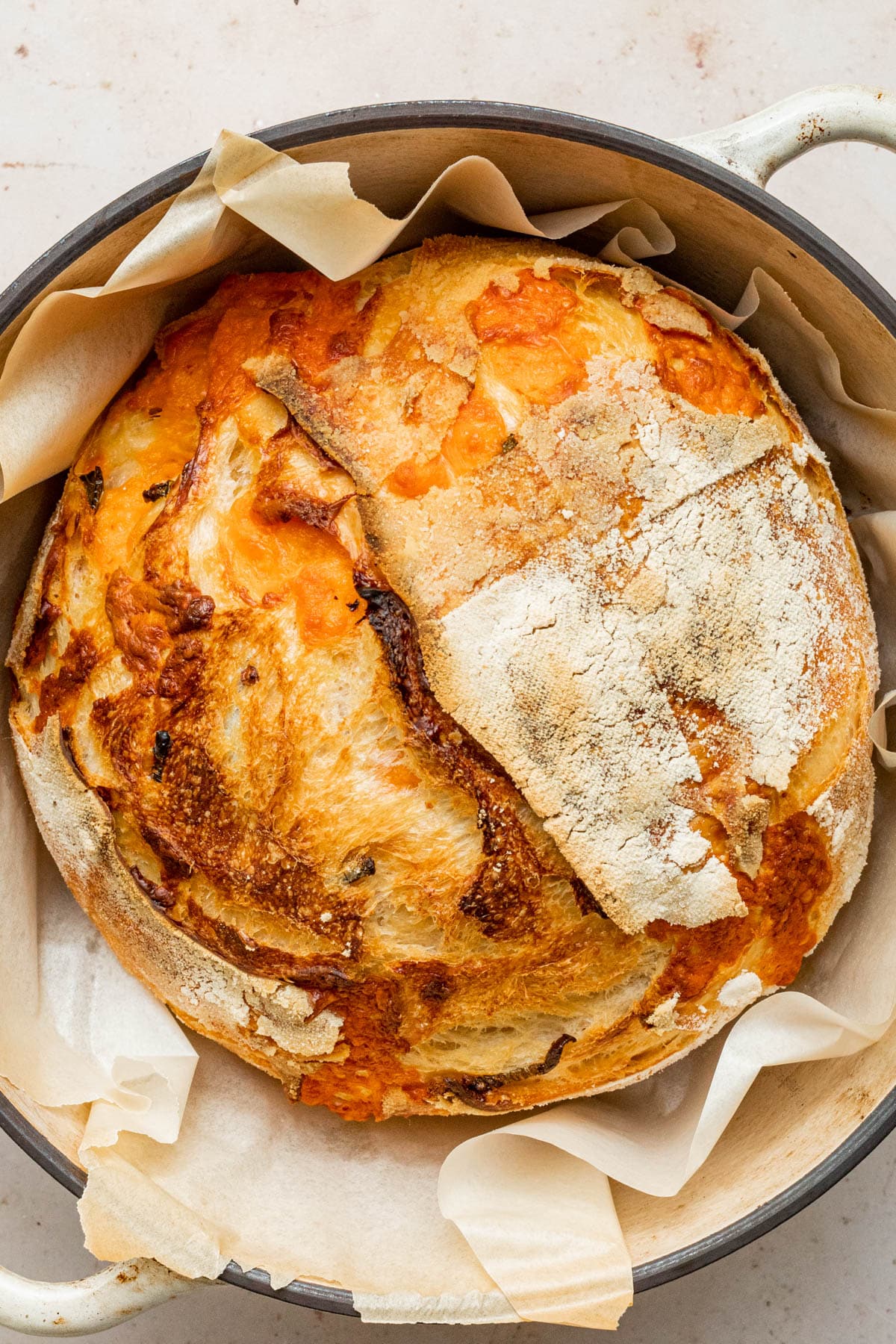
Can you leave the bread dough in the fridge for a longer time to strengthen the sourdough flavor?
Hi Brenda, yes you can leave the dough in the fridge a little longer—but I wouldn't exceed a 48 hour rest.
Excellent recipe, I've made this lots of times now with different cheeses, always comes out delicious and keeps for 5 days well for toast, or 3 and freeze half.